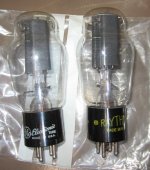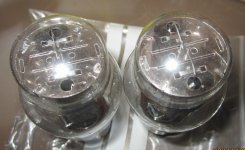Two here on ebay for $20 - <>83-V-Two hard to find #83-V Rectifier Tubes- Sylvania/RCA NIB –TV-7 Tested<> | eBay as are SS replacements - Regulated Solid State 83 Replacement Rectifier ~ TV-7 Hickok B&K Tube Testers | eBay.
Andy.
Andy.
Two here on ebay for $20
These are the V - clearly unsuitable. The SS imitations otoh are great as it's a sin to waste prime mercury on a tube tester
Hi analog_sa,
You are correct. Thanks for looking for them Andy.
What would you consider a worthy use for a #83 rectifier?
-Chris
You are correct. Thanks for looking for them Andy.
But, they are true transconductance type tube testers, not emission testers. Stark 9-66 types.The SS imitations otoh are great as it's a sin to waste prime mercury on a tube tester
What would you consider a worthy use for a #83 rectifier?
-Chris
Hi Andy,
The 83V doesn't have any Mercury inside them. It is a high vacuum rectifier much like a 5U4 with its higher and more variable voltage drop.
The 83 is a gas rectifier that uses Mercury in this case. What the effect of the Mercury is, is to have a lower voltage drop of approximately 15 V. This doesn't vary very much with current. So for something like a tube tester, when you test larger tubes, like a 6L6, or a KT88, the higher current draw doesn't drop the voltage much from it's normal resting state voltage. For other equipment, the 83 can handle higher currents because the voltage drop is lower and so the tube doesn't get as hot. Normal rectifier tubes can drop 60 V and that creates a lot of heat very quickly.
Because the 83 isn't like other rectifiers, and therefore has some care and feeding issues a user needs to know about. It doesn't like to be disturbed for one. It also needs an extended warm-up time. You can kill them if you don't use them properly.
-Chris
The 83V doesn't have any Mercury inside them. It is a high vacuum rectifier much like a 5U4 with its higher and more variable voltage drop.
The 83 is a gas rectifier that uses Mercury in this case. What the effect of the Mercury is, is to have a lower voltage drop of approximately 15 V. This doesn't vary very much with current. So for something like a tube tester, when you test larger tubes, like a 6L6, or a KT88, the higher current draw doesn't drop the voltage much from it's normal resting state voltage. For other equipment, the 83 can handle higher currents because the voltage drop is lower and so the tube doesn't get as hot. Normal rectifier tubes can drop 60 V and that creates a lot of heat very quickly.
Because the 83 isn't like other rectifiers, and therefore has some care and feeding issues a user needs to know about. It doesn't like to be disturbed for one. It also needs an extended warm-up time. You can kill them if you don't use them properly.
-Chris
Hi,
Does anyone have any new # 83 rectifiers (not 83V). I need them for a pair of tube testers. Shipping to the Toronto, Ontario area.
As long as the prices are reasonable, I'm good. Used ones might not be worth the shipping cost. Depends on the shipping.
-Chris
Don't know if the price is outside of your limit. But this is supposed to be a NOS 83.
NOS SYLVANIA # 83 Rectifier VACUUM TUBE B&K 747 Hickok Tube TESTERS #C.6673 | eBay
Hi Glen,
Thank you!
Yes, the combination of exchange rate, asking price and shipping (not too bad in this case) comes to more than I can spend right now. Then there is the fact that these are just workhorse rectifiers. There isn't anything special about them to command those prices. If it said "Marantz" on it I guess it would be $200 US. These used to be cheap, so when they became expensive, I don't know. The market seems to be treating these as special output tubes or something. In fact, the last rectifier you would want in a piece of stereo equipment would be the # 83 rectifier as it generates a fair amount of electronic noise. They have their reason for being. Audio isn't one of them. Not only that, but they do contain Mercury. Not what you really want around your family in case the glass breaks.
If anyone here replaced their high vacuum rectifier with a #83 tube in hopes of improving performance, get them out of there and go back to the high vacuum rectifier your equipment was designed for.
-Chris
Thank you!
Yes, the combination of exchange rate, asking price and shipping (not too bad in this case) comes to more than I can spend right now. Then there is the fact that these are just workhorse rectifiers. There isn't anything special about them to command those prices. If it said "Marantz" on it I guess it would be $200 US. These used to be cheap, so when they became expensive, I don't know. The market seems to be treating these as special output tubes or something. In fact, the last rectifier you would want in a piece of stereo equipment would be the # 83 rectifier as it generates a fair amount of electronic noise. They have their reason for being. Audio isn't one of them. Not only that, but they do contain Mercury. Not what you really want around your family in case the glass breaks.
If anyone here replaced their high vacuum rectifier with a #83 tube in hopes of improving performance, get them out of there and go back to the high vacuum rectifier your equipment was designed for.
-Chris
- Status
- This old topic is closed. If you want to reopen this topic, contact a moderator using the "Report Post" button.

